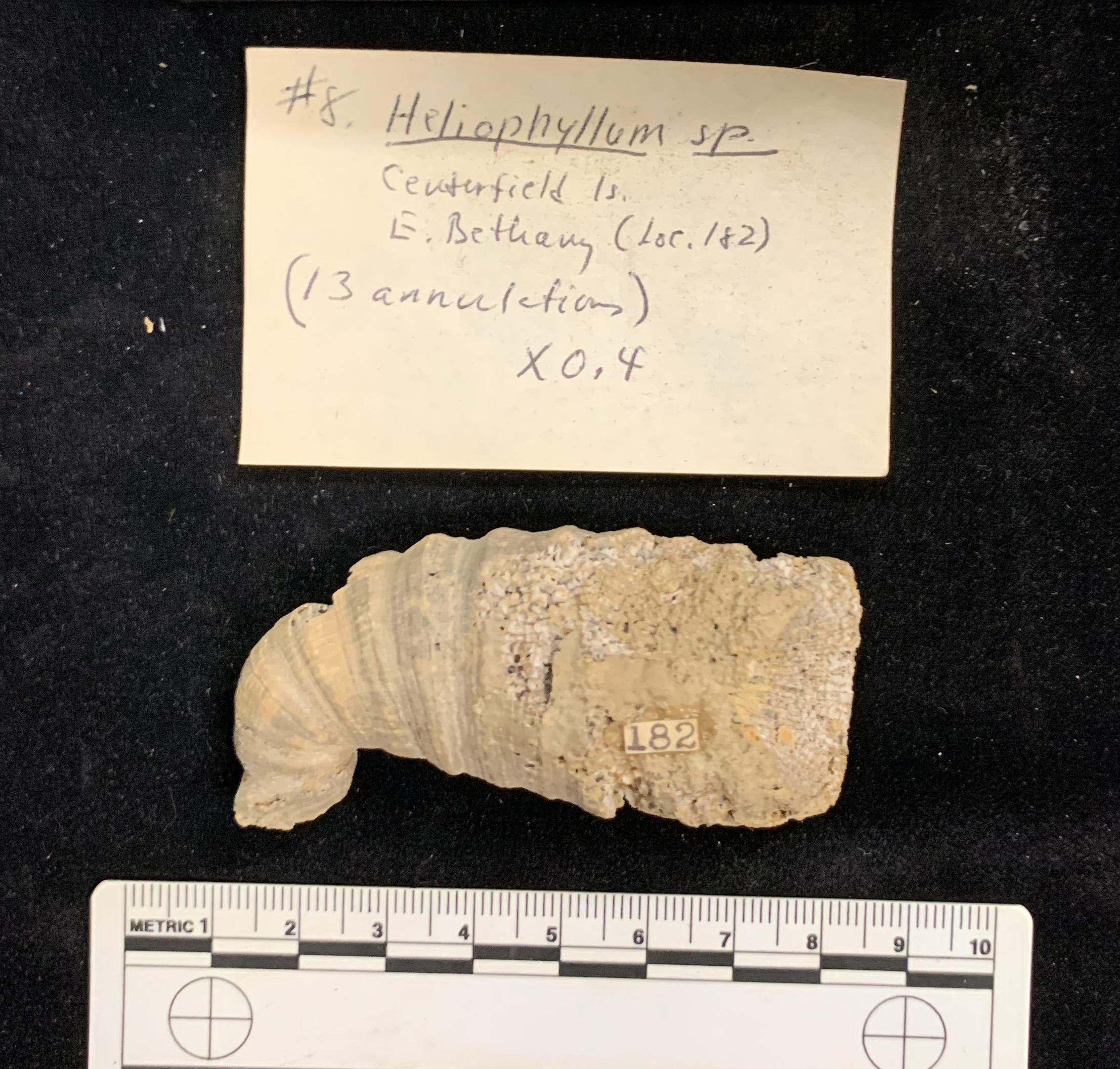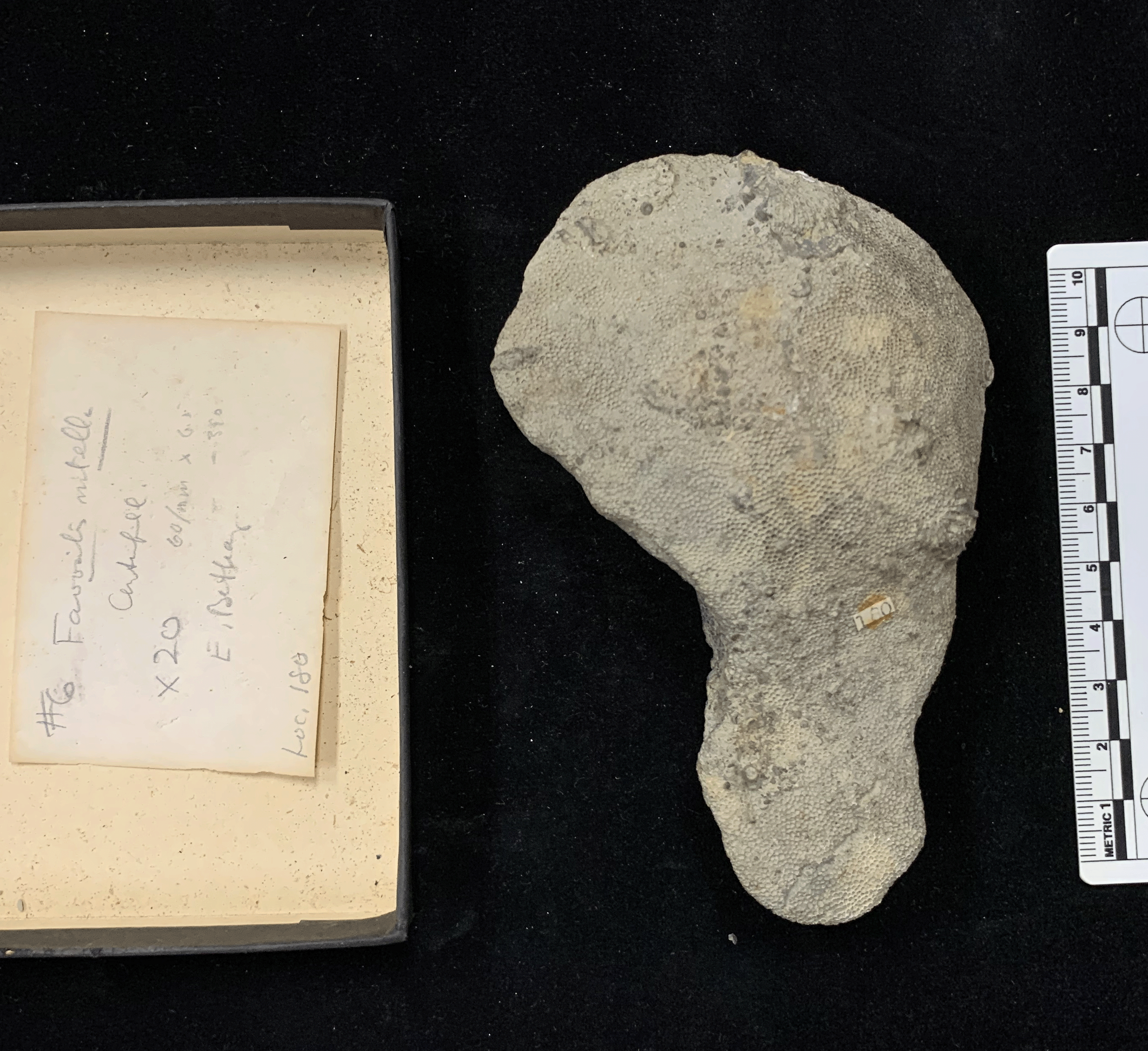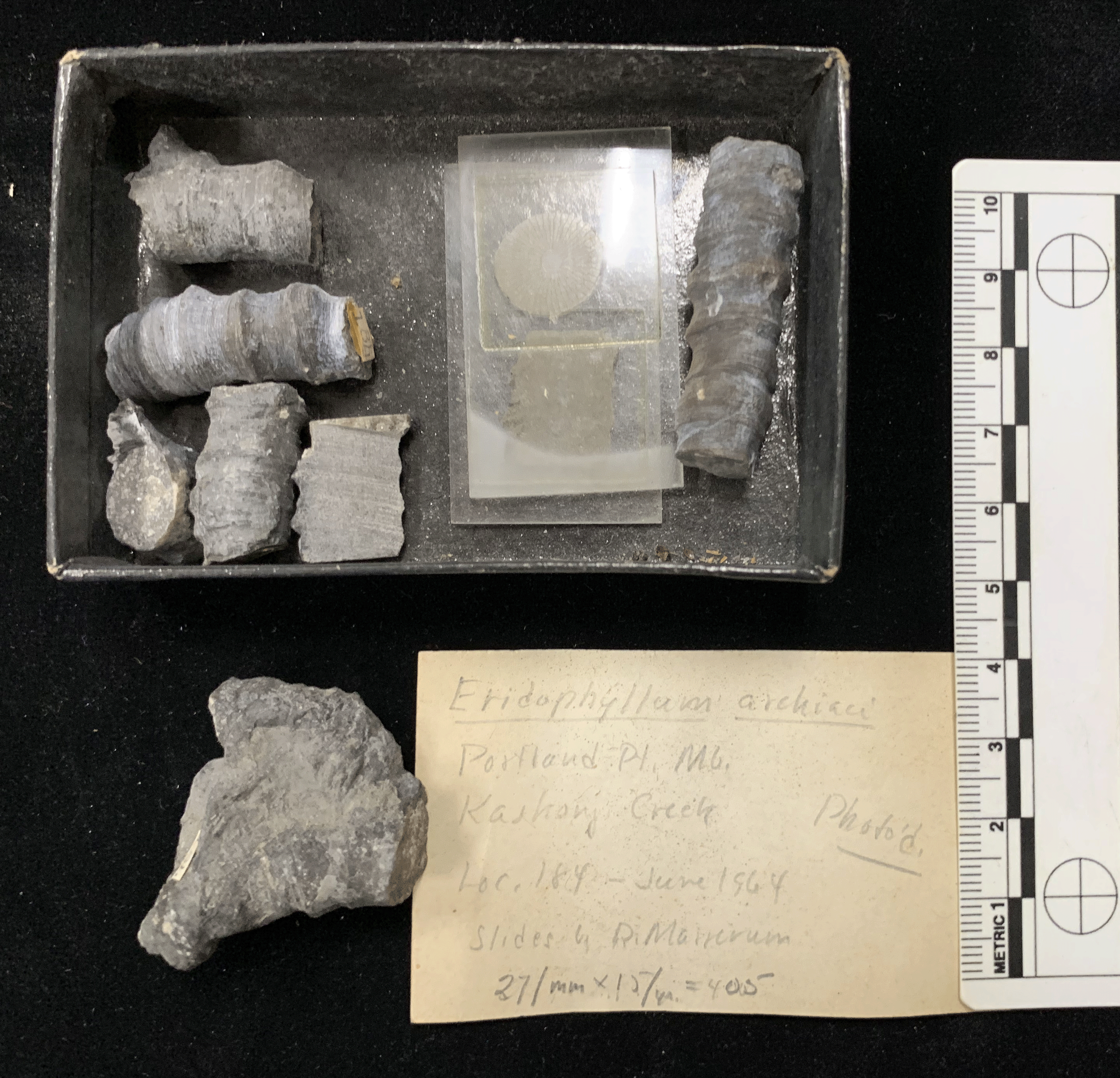John W. Wells & Coral Geochronometry
John W. Wells (1907-1994) alongside boxes of his Devonian coral specimens, now housed in the collections at PRI.
by Kiera D. Crowley, Research Assistant to the Director
March 9, 2023
Sixty years ago today, John W. Wells (1907-1994) published his landmark paper titled “Coral Growth and Geochronometry” in the journal Nature.[1] In little more than two pages, he showed how the growth lines in fossil corals could be used as independent evidence of a phenomenon which geophysicists and astronomers had theorized about for centuries: the number of days in a year on Earth has not always been 365.[2] This simple yet profound paper would inspire numerous paleontologists in the following decades to expand upon Wells’s idea of using growth lines in other corals, mollusks, and stromatolites to understand Earth’s past.
Academic Career
At the time the paper was published in 1963, Wells was a professor at Cornell University. Having grown up roughly 20 miles from Cornell’s campus, in Homer, NY, Wells would ultimately spend much of his life in the area. It was in pursuit of his undergraduate degree at the University of Pittsburgh that he grew fond of geology and paleontology under the tutelage of two Cornell graduates, Ransom E. Sommers and Henry Leighton.[3] Leighton encouraged Wells to continue his studies in paleontology, and directed him toward Gilbert D. Harris, professor of paleontology and stratigraphy at Cornell (who in 1932 would found the Paleontological Research Institution). Wells did just that, and received his M.A. in 1930 and Ph.D. in 1933 under Harris’s guidance. He would go on to teach at the University of Texas, the State Normal School (SUNY) at Fredonia NY, and Ohio State University before finally returning to Cornell University in 1948, where he would teach until his retirement in 1973.[4]
Wells was an expert on the taxonomy and biology of scleractinian corals, the group of corals that first arose in the early Mesozoic Era (~240 million years ago) and remain the dominant reef-building corals in our oceans today.[5] Of his 174 publications over 56 years of research activity, “over half… addressed some aspect of scleractinian biology.”[6] While his earlier work focused solely on fossils, his affiliation with the U.S. Geological Survey, which started in the mid-1940s, took him on a number of field expeditions to Pacific islands such as the Bikini and Arno Atolls where he began to conduct research on living corals as well. It was supposedly “while studying these living corals and their diurnal habits (active in the daytime and more dormant at night)” that Wells began to think about fossil corals with regard to the same behavior.[7] This seed of an idea – looking for evidence of daily activity changes in fossil corals – would be the basis for Wells’s 1963 paper in Nature.
Polyps of the colonial scleractinian coral Montastraea cavernosa, which lives in the Caribbean. This specimen is on exhibit at the Museum of the Earth, Ithaca, New York. Image by Jonathan R. Hendricks.
Coral Geochronometry
Physicists had long hypothesized that the rate of Earth’s rotation has very gradually slowed over time due to the moon’s gravitational pull on Earth’s ocean water (termed “tidal friction”).[8] If this is true, then in the geologic past the Earth must have been spinning faster than it is today. Because there is no evidence that the solar year– the time it takes for the Earth to orbit the sun– has changed, each day on Earth would be shorter than 24 hours, and each year longer than 365 days. But no one had proposed how this could be tested empirically. Wells, however, wondered whether paleontology could “give any support to the shaky chronometric creation of the geophysicists and astronomers?”[9]
Yes, it turns out, paleontology could. Corals are composed of a fleshy polyp that grows upwards out of a calcium carbonate skeleton. Their outermost skeletal wall (the epitheca) bears numerous growth lines. From studying modern corals in the Pacific islands, Wells knew that these growth lines formed by corals adding to their skeletons just a little bit every day. He also knew that corals produced thickened growth bands (“annulations”) once per year, like tree rings, due to seasonal changes in water conditions.[10] So, if he could count the number of daily growth lines in one annual growth band, he could figure out the number of days in the year when the coral was living.
Two specimens of Wells’ Devonian corals from PRI’s collections: (Left) Specimen of Bethanyphyllum robustum, with fine growth lines on the skeletal epitheca and location of non-fossilized polyp indicated; (Right) Individual of Heliophyllum sp. (PRI 83105), with yearly growth annulations marked.
Reflecting on “fossil clocks” such as Wells’s corals, British geophysicist S. K. Runcorn stated in 1966, “if a coral could be accurately assigned to a particular geological period (by radioactive dating or the evidence of stratigraphy), it would provide a measurement of the number of days in the year at that time. Corals thus [held] the promise of being a powerful geophysical tool.”[11]
Focusing on the abundant and well-preserved Devonian corals of Central New York, Wells counted the growth bands in specimens of a number of genera, including Heliophyllum, Eridophyllum, and Favosites, finding on average ~400 lines per annulation. Compared to modern corals, such as Manicinia areolata, which he found to have an average of ~360 growth lines per annulation, this did indeed point to a change in the number of days per year over geologic time! Further, when he performed the same measurement on the coral taxon Lophophyllidium, living in the Carboniferous Period immediately following the Devonian, he found an average of 390 growth lines per annum.[12] As William Brice noted in his memorial to Wells in 1996, “This discovery came at a time when “big science” was the order of the day and huge sums of money were being spent on equipment and research. J. B. S. Haldane, the British scholar, noted this fact in a New York Times article and pointed out that great science can still be done with nothing more complex than a hand lens and careful observation.”[13]
Wells’s “lost” specimens
Sometime in the mid-1990s, when the contents of Wells’s office were transferred to PRI, the Devonian coral specimens which Wells measured and figured in his 1963 Nature paper must have arrived at PRI too. But as is so often the case in natural history museum collections, entropy wins out… and amongst the 1500 drawers of fossils and boxes of reference literature that made the move, the exact location of those specific corals was not known at the time. Decades later, it was assumed that they were “lost” somewhere in PRI’s collections, as they were nowhere to be found in the type cabinets or other obvious places where published specimens are normally stored.
Unassuming boxes that were discovered to house Wells’ fossil coral specimens measured and figured in his 1963 paper “Coral Growth and Geochronometry.” Photo by Jonathan Hendricks.
That was, until November 25th, 2019, when a collections worker noticed two unassuming boxes labeled “Coral Chronology Material” while searching for completely unrelated specimens in the Cornell University Paleozoic stratigraphic collection. After comparing the corals against the material mentioned in Wells’s papers, and recognizing Wells’s own handwriting on labels alongside cryptic notations about growth lines and annulations, it became clear that the infamous specimens had been found!
Acknowledgments
Thanks to Jon Hendricks and Vicky Wang for sharing images and locating Wells’s specimens, and Warren Allmon for comments on an earlier draft.
Notes
[1] Wells (1963)
[2] Runcorn (1975, pp. 285-286)
[3] Brice (1996, p. 426)
[4] Brice (1996, p. 425)
[5] https://www.digitalatlasofancientlife.org/learn/cnidaria/anthozoa/scleractinia/
[6] Oliver & Cairns (1994, p. 121)
[7] Brice (1966 p. 430)
[8] https://www.digitalatlasofancientlife.org/learn/cnidaria/anthozoa/rugosa/
[9] Wells (1963, p. 948)
[10] https://www.digitalatlasofancientlife.org/learn/cnidaria/anthozoa/rugosa/; Wells (1963, p. 949)
[11] Runcorn (1966, p. 26)
[12] Wells (1963, p. 950)
[13] Brice (1996, p. 431)
References and Further Reading
Brice, W. R., 1996, John West Wells (1907–1994): A Biographical Memoir. Biographical Memoirs, National Academy of Sciences, 70: 423–437.
Oliver, W. A., Jr. & S. D. Cairns, 1994, Memorial to John West Wells (1907–1994). Geological Society of America Memorials, 25(Nov. 1994): 121–124.
Pannella, G., 1975, Palaeontological clocks and the history of the Earth’s rotation. Pp. 253–284, in: G. D. Rosenberg & S. K. Runcorn, eds., Growth rhythms and the history of the Earth’s rotation. John Wiley & Sons, London. xvi + 558 pp.
Runcorn, S. K., 1966, Corals as Paleontological Clocks. Scientific American, 215(4): 26–33.
Runcorn, S. K., 1975, Paleontological and astronomical observations on the rotational history of the Earth and Moon. Pp. 285–291, in: G. D. Rosenberg & S. K. Runcorn, eds., Growth rhythms and the history of the Earth’s rotation. John Wiley & Sons, London. xvi + 558 pp.
Wells, J. W., 1963, Coral growth and geochronometry. Nature, 197(4871): 948–950.
Check out the Digital Atlas pages on Scleractinian, Rugose, and Tabulate corals for more 3D models and details on coral biology.








